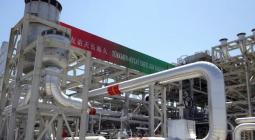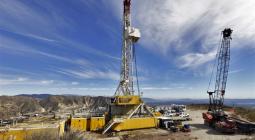US energy industry gas leaks are triple the official figures, study finds
Leaks of heat-trapping methane – about 3% of gas produced in US – cost $9.3bn yearly in climate damage, but the problem is fixable
US oil and natural gas wells, pipelines and compressors are spewing three times the amount of the potent heat-trapping gas methane as the government has determined, causing $9.3bn in yearly climate damage, a new comprehensive study calculates.
But because more than half of these methane emissions are coming from a tiny number of oil and gas sites, 1% or less, this means the problem is both worse than the government has determined but also fairly fixable, said the lead author of a study in the journal Nature.
The same issue is happening globally. Large methane emissions events around the world detected by satellites grew 50% in 2023 compared with 2022 with more than 5m metric tons spotted in major fossil fuel leaks, the International Energy Agency reported on Wednesday in its Global Methane Tracker 2024 report. World methane emissions rose slightly in 2023 to 120m metric tons, the report said.
“This is really an opportunity to cut emissions quite rapidly with targeted efforts at these highest-emitting sites,” said lead author Evan Sherwin, an energy and policy analyst at the US Department of Energy’s Lawrence Berkeley National Lab who wrote the study while at Stanford University. “If we can get this roughly 1% of sites under control, then we’re halfway there because that’s about half of the emissions in most cases.”
Sherwin said the fugitive emissions were produced throughout the oil and gas production and delivery system, starting with gas flaring. That’s when firms release natural gas into the air or burn it instead of capturing it as it is produced during energy extraction. There are also substantial leaks throughout the rest of the system, including tanks, compressors and pipelines, Sherwin said.
“It’s actually straightforward to fix,” he said.
In general, about 3% of the US gas produced is wasted and released into the air, compared with the Environmental Protection Agency figures of 1%, the study found. Sherwin said that was a substantial amount, about 6.2m tons an hour in leaks measured over the daytime. It could be lower at night, but it has not been measured.
The study arrived at the figure using 1m anonymized measurements from aircraft that flew over 52% of American oilwells and 29% of gas production and delivery system sites over a decade. Sherwin said the 3% leak figure is the average for the six regions the study looked at, and a national average was not calculated.
Methane over a two-decade period traps about 80 times more heat than carbon dioxide, but only lasts in the atmosphere for about a decade instead of the hundreds of years that carbon dioxide does, according to the US Environmental Protection Agency.
About 30% of the world’s warming since preindustrial times comes from methane emissions, said the International Energy Agency energy supply unit head, Christophe McGlade. The US is the No 1 oil and gas production methane emitter, with China polluting even more methane from coal, he said.
Last December, the Biden administration issued a new rule forcing the US oil and natural gas industry to cut its methane emissions. At the same time at the United Nations climate negotiations in Dubai, 50 oil companies around the world pledged to reach near zero methane emissions and end routine flaring in operations by 2030. That Dubai agreement would trim about one-tenth of a degree celsius (nearly two-tenths of a degree fahrenheit) from future warming, a prominent climate scientist told the Associated Press.
Monitoring methane from above, instead of at the sites or relying on company estimates, is a growing trend. Earlier this month the market-based Environmental Defense Fund and others launched the MethaneSat observation satellite into orbit to monitor methane emissions. For energy companies, the lost methane is valuable, with Sherwin’s study estimating it is worth about $1bn a year.
Cover photo: World methane emissions rose slightly in 2023 to 120m metric tons. Photograph: Lano Lan/Alamy




